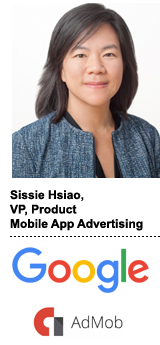
Google on Tuesday revealed two products at Google I/O designed to drive app downloads.
The first is the ability to show app content in an ad. The second, for game developers, is called Google Play Instant and gives consumers the ability to try the game in an ad unit before downloading it. Read the blog post.
The products are both in beta for Universal App Campaigns, which promote apps across all Google properties. They will become generally availability over the next few months, said Sissie Hsiao, VP of product for Google App Ads.
The first product is designed for app developers showcasing many products that appeal to different people, Hsiao said. Shopping apps like Wish, movie apps like Netflix or dating apps can link their product catalog to Google and let its machine learning automatically figure out what types of ads they should show to different users, based on their search queries and contexts.
For instance, Wish can link its product catalog to AdWords to show ads featuring children’s apparel depending on the search query. Or Universal App Campaigns decide the best TV shows to promote to certain segments, Hsiao said.
The second product, Google Play Instant, lets users play the first level of a game after a relevant search query, or in other contexts where it makes sense to present the gaming, like after clicking on an interstitial. But, ultimately, machine learning makes the call.
“If we show [the Google Play Instant ad] or not depends on if the machine learning determines it performs well,” Hsiao said.
Mo metrics
Google also added the ability for developers to track view-through conversions for app downloads. A view-through conversion is when a consumer sees the app, doesn’t click on it, but downloads it at a later time.
The move allows apples-to-apples comparisons with other major platforms that already allow view-through tracking, Hsiao said. But view-through conversions are not yet a signal that the machine learning uses, especially because many app developers only focus on click-through conversions.
Publisher rewards
On the publisher side, Google added two perks to improve app monetization. First, app publishers and their advertisers can measure viewability through an integration with the IAB Tech Lab Open Measurement SDK. This integration will especially help publishers selling direct deals with viewability requirements.
Second, publishers will have more ways to test rewarded video. Publishers can analyze what placements of rewarded video perform the best and how much revenue per user they’re generating. Publishers can also perform A/B tests to determine what entices users to watch rewarded ads.
All the testing and optimization is currently manual, Hsiao said. But future machine learning may guide the publisher side of ad optimization as well.
This post was syndicated from Ad Exchanger.

More Stories
The Fin Tech Ad Tech Boom; Temu Tops Meta’s Charts (But At What Cost?)
Brother: NZ Marketing Awards celebrate industry success
AI Search Startup Perplexity’s Series B Funding Raises Nearly $63M, Launches Enterprise Pro